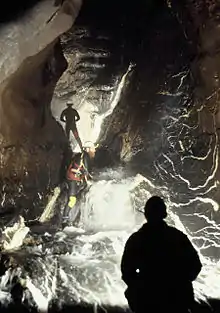Ogof Ffynnon Ddu
Ogof Ffynnon Ddu (Welsh for cave of the black spring), also known informally as OFD, is a cave under a hillside in the area surrounding Penwyllt in the Upper Swansea Valley in South Wales. It is the second longest cave in Wales and the deepest in the United Kingdom.
| Ogof Ffynnon Ddu | |
|---|---|
| Location | Upper Swansea Valley |
| Coordinates | 51.8243°N 3.6611°W |
| Depth | 274.5 metres (901 ft)[1] |
| Length | 59 kilometres (37 mi)[2] |
| Discovery | South Wales Caving Club 1946 |
| Geology | Limestone |
| Entrances | 3 |
| Access | South Wales Caving Club—see website for details |
| Translation | cave of the black spring (Welsh) |
| Cave survey | https://web.archive.org/web/20051231004412/https://static.swcc.org.uk/caving/caves/ofdline3.jpg |

History
OFD was discovered in 1946 through digging by Peter Harvey and Ian Nixon, members of the newly formed South Wales Caving Club.[3] Exploration beyond the Boulder Chamber in 1957 revealed passages as far as the Dip Sump. Major extensions were discovered in 1967 through to Cwm Dŵr, which is now known as OFD2. The system is famous for its intricate maze-like structure and its impressive main stream passage.[4]
It is now part of the Ogof Ffynnon Ddu National Nature Reserve which includes the ruined remains of a former brickworks, including several kilns, quarry workings and tramroad tracks. The terrace of workers' cottages is now occupied by the South Wales Caving Club.[5]
The cave system
With a depth of 274 m (900 ft) and at least 50 kilometres (31 mi) long, it is the deepest cave in the UK and the second longest in Wales. One of the largest cave systems in Britain, the passages and chambers of Ogof Ffynnon Ddu weave a long and tortuous path beneath the east side of the Tawe Valley. The stream passage cuts through black limestone producing waterfalls, rapids, deep pot holes and scalloped walls.[4] The system is divided into three parts, the lowermost (western) section is referred to as Ogof Ffynnon Ddu I (or simply OFDI), the central section as Ogof Ffynnon Ddu II (or OFDII) and the uppermost (eastern) section as Ogof Ffynnon Ddu III (or OFDIII).[6]
An assortment of specialised wildlife has developed underground including cave shrimps and the pale blanched trout endemic to pure underground fresh water courses with sufficient plankton.[7] Deep cracks in the vast expanse of stony moorland above provide habitats for plant life, including the lily of the valley and wood anemone, and mossy saxifrage (Saxifraga hypnoides) grows on the limestone outcrops.[5]
National Nature Reserve
The name Ogof Ffynnon Ddu has also been given to an extensive tract of moorland, rocks and cave systems of which the eponymous cave is a part. It was designated as an NNR because of its unique geology, floristic diversity, its induatrial past and its subterranean animal and plant life[8]
References
- "Ogof Ffynnon Ddu - Surveys". South Wales Caving Club. Retrieved 21 September 2015.
- "Ogof Ffynnon Ddu 1". Cambrian Cave Registry. Cambrian Caving Council. Retrieved 4 November 2019.
- Cave discovery anniversary marked BBC Wales - 16 September 2007
- "Ogof Ffynnon Ddu 1". Caves of South Wales. Retrieved 28 April 2016.
- "Ogof Ffynnon Ddu National Nature Reserve". First Nature. Retrieved 28 April 2016.
- Ogof Ffynnon Ddu, Penwyllt, Brecknockshire, cave survey published by South Wales Caving Club, 2014
- Ford, Trevor D. (2011). Limestones and Caves of Wales. Cambridge University Press. p. 59. ISBN 978-0-521-16913-4.
- "Ogof Ffynnon Ddu National Nature Reserve, near Ystradgynlais". Natural Resources Wales. Retrieved 3 September 2020.
External links
| Wikimedia Commons has media related to Ogof Ffynnon Ddu National Nature Reserve. |